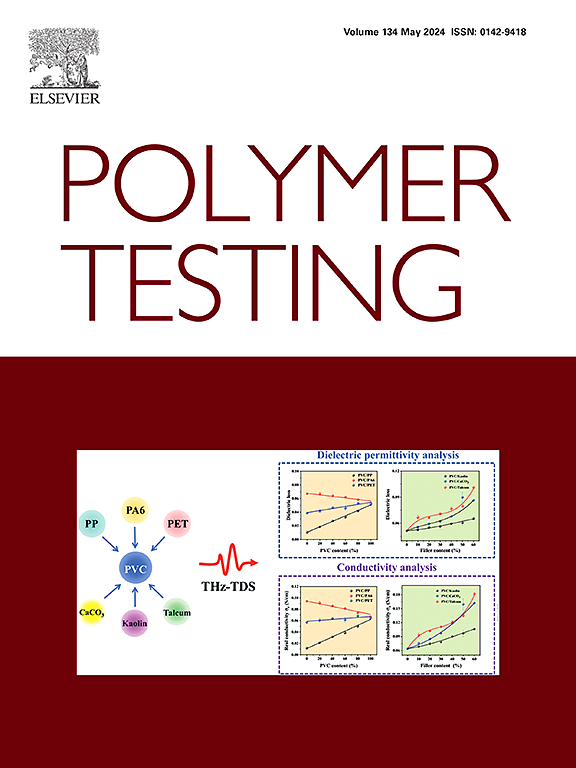Mechanical performance of 3D-printed TPU auxetic structures for energy absorption applications
IF 5
2区 材料科学
Q1 MATERIALS SCIENCE, CHARACTERIZATION & TESTING
引用次数: 0
Abstract
The emergence of metamaterials and layered structures obtained through additive manufacturing (AM) techniques opens a new paradigm of mechanical properties for advanced applications that need to be explored. This study investigates the mechanical behavior of 3D-printed auxetic structures, fabricated from thermoplastic polyurethane (TPU), under tensile and compressive loads. Utilizing fused deposition modeling (MEX), we examined the influence of printing direction on the anisotropic mechanical properties of TPU, with a particular focus on energy absorption, stress–strain responses, and damping capabilities. The research employs the Ogden model for hyperelastic characterization, demonstrating excellent correlation with experimental data. Thus, the novelty of this work relies on an approach that – with a focus in the precision and accuracy of the mechanical performance assessment – through a robust novel methodology combining the Ogden’s analytical model with numerical simulation provided by Ansys® and experimental tests of tensile and compression allows to comprehensively understand the mechanical performance of novel auxetic structures intended to energy absorption and impact resistance applications. Our findings reveal significant variations in mechanical performance based on printing orientation, with the 0°direction offering superior ductility and strength. These results suggest that optimizing the printing direction is crucial for enhancing the performance of TPU auxetic structures, particularly in applications requiring high impact resistance, energy absorption, and damping. This study contributes to the advancement of 3D printing technology for the development of next-generation materials with potential applications in protective gear, medical devices or damping devices, among others.
3d打印TPU吸能结构的力学性能研究
通过增材制造(AM)技术获得的超材料和层状结构的出现,为需要探索的先进应用开辟了机械性能的新范例。本研究探讨了热塑性聚氨酯(TPU)制造的3d打印增塑型结构在拉伸和压缩载荷下的力学行为。利用熔融沉积模型(MEX),我们研究了打印方向对TPU各向异性力学性能的影响,特别关注能量吸收、应力应变响应和阻尼能力。本研究采用Ogden模型进行超弹性表征,与实验数据具有良好的相关性。因此,这项工作的新颖性依赖于一种方法-重点是机械性能评估的精度和准确性-通过一种强大的新方法,将Ogden的分析模型与Ansys®提供的数值模拟和拉伸和压缩实验测试相结合,可以全面了解旨在吸收能量和抗冲击应用的新型辅助结构的机械性能。我们的研究结果揭示了基于印刷方向的机械性能的显著变化,0°方向提供了优越的延展性和强度。这些结果表明,优化打印方向对于提高TPU增氧结构的性能至关重要,特别是在需要高抗冲击性,能量吸收和阻尼的应用中。这项研究有助于3D打印技术的进步,用于开发下一代材料,在防护装备、医疗设备或阻尼装置等方面具有潜在的应用前景。
本文章由计算机程序翻译,如有差异,请以英文原文为准。
求助全文
约1分钟内获得全文
求助全文
来源期刊

Polymer Testing
工程技术-材料科学:表征与测试
CiteScore
10.70
自引率
5.90%
发文量
328
审稿时长
44 days
期刊介绍:
Polymer Testing focuses on the testing, analysis and characterization of polymer materials, including both synthetic and natural or biobased polymers. Novel testing methods and the testing of novel polymeric materials in bulk, solution and dispersion is covered. In addition, we welcome the submission of the testing of polymeric materials for a wide range of applications and industrial products as well as nanoscale characterization.
The scope includes but is not limited to the following main topics:
Novel testing methods and Chemical analysis
• mechanical, thermal, electrical, chemical, imaging, spectroscopy, scattering and rheology
Physical properties and behaviour of novel polymer systems
• nanoscale properties, morphology, transport properties
Degradation and recycling of polymeric materials when combined with novel testing or characterization methods
• degradation, biodegradation, ageing and fire retardancy
Modelling and Simulation work will be only considered when it is linked to new or previously published experimental results.
 求助内容:
求助内容: 应助结果提醒方式:
应助结果提醒方式:


